Capturing urban wildlife offers a unique opportunity to document nature’s resilience in city environments, but it comes with challenges. Photographers must navigate limited habitats, unpredictable animal behavior, and urban noise. Techniques such as understanding wildlife activity patterns and utilizing natural light can enhance photo quality. This photography also plays a vital role in conservation, raising awareness and documenting ecological changes.
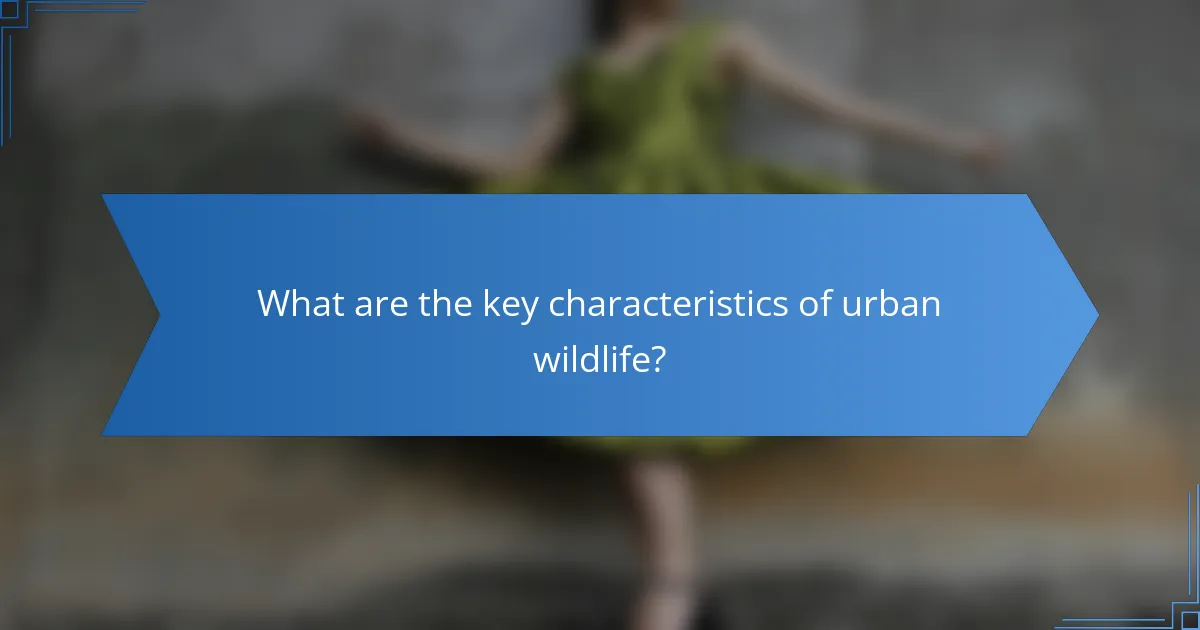
What are the key characteristics of urban wildlife?
Urban wildlife exhibits adaptability, diversity, and resilience, thriving in human-altered environments. Key characteristics include habitat flexibility, species diversity, and behavioral changes. Urban wildlife often utilizes green spaces, parks, and buildings for shelter and food. Species such as raccoons, pigeons, and foxes have adapted to city life, showcasing unique traits like nocturnal foraging and scavenging. The presence of urban wildlife highlights the importance of biodiversity in cities and the need for sustainable urban planning.
How do urban environments influence wildlife behavior?
Urban environments significantly alter wildlife behavior by introducing new challenges and opportunities. Animals adapt to urban settings by changing their feeding patterns, nesting sites, and social interactions. For example, many species exploit human food sources, leading to increased human-wildlife interactions. Urbanization can also create barriers, impacting migration and breeding. Additionally, noise and light pollution influence animal behavior, affecting their communication and reproduction. Understanding these adaptations is crucial for effective wildlife photography and conservation efforts in cities.
Which species are commonly found in cities?
Cities commonly host species such as pigeons, squirrels, raccoons, and various songbirds. These animals adapt well to urban environments, finding food and shelter in human structures. Pigeons thrive due to their ability to forage on discarded food. Squirrels utilize trees and parks for nesting and foraging. Raccoons are known for scavenging in urban areas, showcasing their intelligence. Songbirds often nest in gardens and parks, contributing to urban biodiversity.
How does urban wildlife adapt to human presence?
Urban wildlife adapts to human presence by altering their behaviors and habitats. They often become more nocturnal to avoid human activity, utilize urban structures for shelter, and adapt their diets to include human food sources. For example, raccoons and pigeons thrive in cities due to their resourcefulness. As a result, urban wildlife can maintain their populations despite the challenges posed by urban environments.
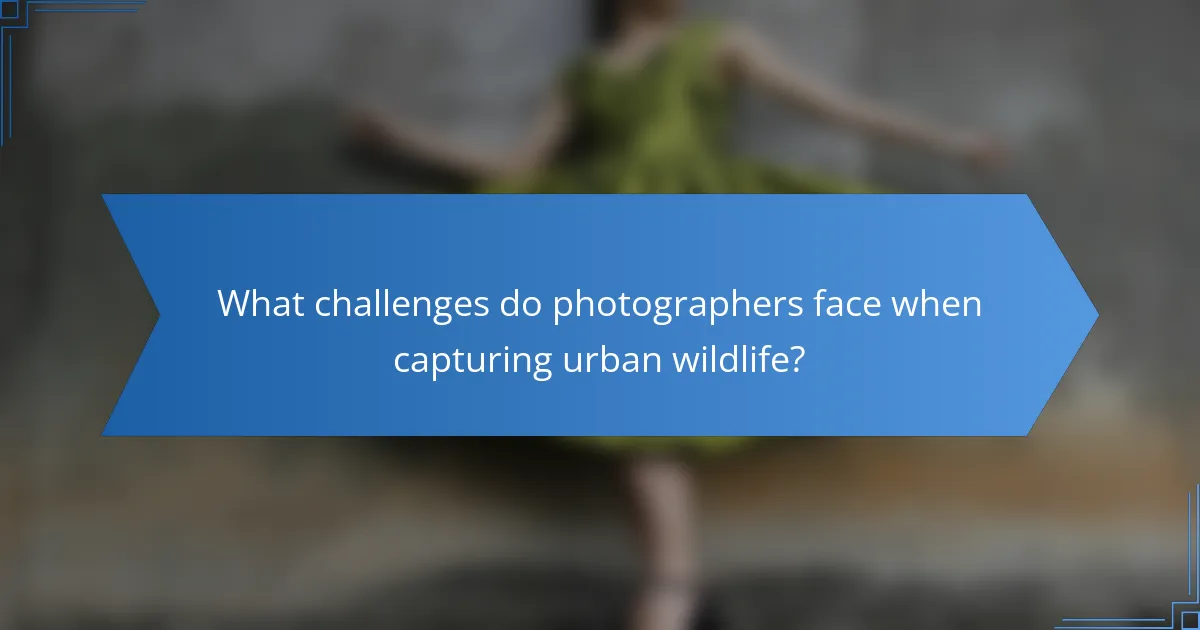
What challenges do photographers face when capturing urban wildlife?
Photographers face several challenges when capturing urban wildlife, including limited access to natural habitats, unpredictable animal behavior, and interference from human activity. Urban environments often restrict the natural movement and feeding patterns of wildlife, making it difficult to find subjects. Additionally, noise and pollution can deter animals, impacting the quality of photographs. Lighting conditions in cities can also be challenging, requiring photographers to adapt their techniques.
How do urban landscapes affect photographic opportunities?
Urban landscapes offer diverse photographic opportunities but present unique challenges for capturing wildlife. The contrast between natural elements and urban structures can create striking visuals. However, noise, pollution, and human activity often disrupt wildlife behavior, making it harder to photograph them effectively. Additionally, urban environments may limit access to certain habitats, reducing the variety of species available for photography. Understanding these dynamics is essential for urban wildlife photographers aiming to balance artistic vision with practical challenges.
What are the ethical considerations in photographing wildlife in cities?
Ethical considerations in photographing wildlife in cities include minimizing disturbance, respecting habitats, and ensuring animal safety. Photographers should avoid feeding wildlife, which can alter natural behaviors. Additionally, it is crucial to maintain a safe distance to prevent stress or harm to animals. Understanding local laws and regulations regarding wildlife photography is also essential to act responsibly and ethically.
How can weather and lighting conditions impact urban wildlife photography?
Weather and lighting conditions significantly influence urban wildlife photography. Overcast days provide softer light, reducing harsh shadows, while sunny days enhance colors and details. Rain can create unique reflections and add mood, but it may limit wildlife activity. Early mornings and late afternoons offer the best natural light, capturing wildlife in their most active states. Understanding these factors helps photographers adapt their techniques for optimal results.
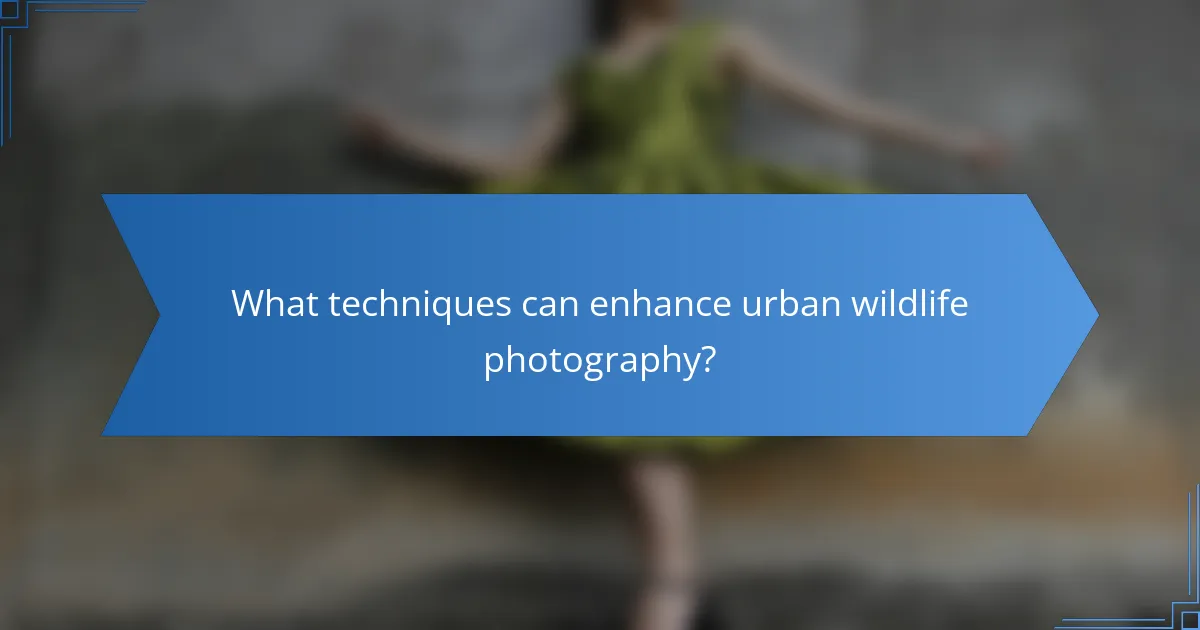
What techniques can enhance urban wildlife photography?
To enhance urban wildlife photography, utilize techniques like patience, knowledge of animal behavior, and strategic positioning. Understanding the best times for wildlife activity, such as early mornings or late afternoons, increases chances of capturing dynamic images. Use natural light to your advantage, avoiding harsh midday sun, which can wash out colors. Employ a zoom lens to maintain distance while still capturing detail, ensuring minimal disturbance to the wildlife. Experiment with different angles and perspectives to create unique compositions that highlight the subject in its urban habitat.
Which equipment is best for photographing wildlife in urban settings?
A telephoto lens, a sturdy tripod, and a fast camera body are essential for photographing urban wildlife. Telephoto lenses allow you to capture distant subjects without disturbing them. A sturdy tripod stabilizes your camera, especially in low light. A fast camera body improves focus speed and performance in dynamic environments.
How can photographers improve their skills in capturing urban wildlife?
Photographers can improve their skills in capturing urban wildlife by practicing patience and observation. Understanding animal behavior enhances timing for perfect shots. Utilize natural light to create depth and texture in images. Experiment with different angles to showcase unique perspectives of wildlife in urban settings. Invest in quality equipment to enhance image clarity and detail.
What role does patience play in successful wildlife photography?
Patience is crucial in successful wildlife photography, especially in urban settings. It allows photographers to wait for the perfect moment to capture elusive animals in their natural behaviors. This practice enhances the quality of images and increases the chances of encountering unique wildlife interactions. Urban environments often present challenges like noise and movement, making patience essential for overcoming distractions and achieving compelling shots. By remaining still and observant, photographers can build rapport with wildlife, leading to more authentic and striking images.
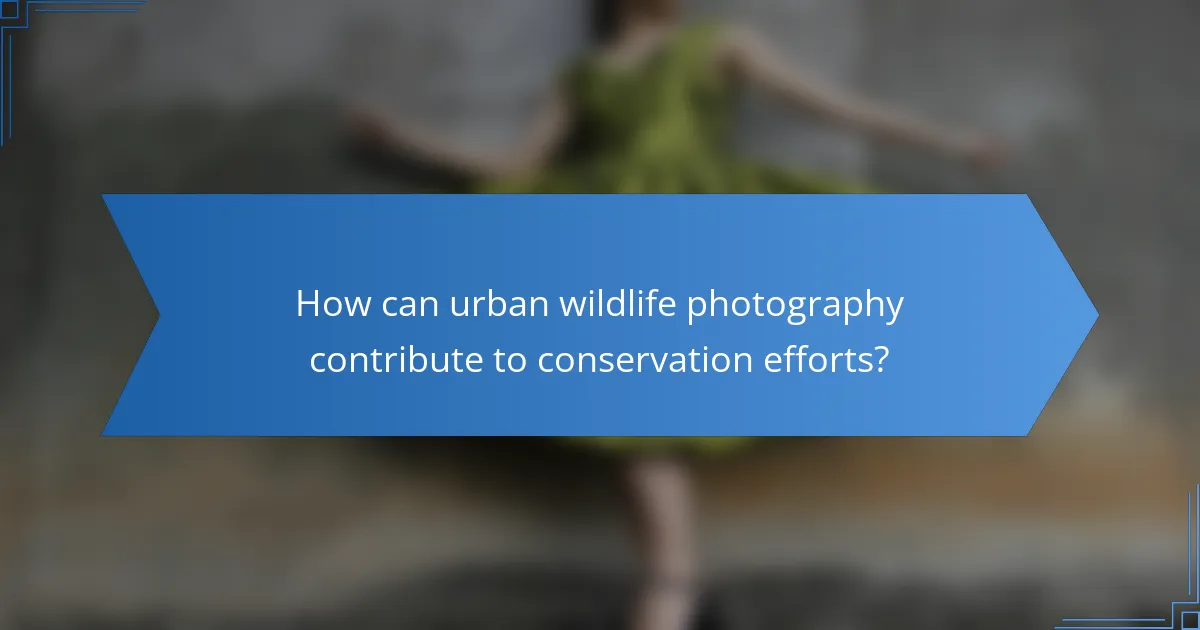
How can urban wildlife photography contribute to conservation efforts?
Urban wildlife photography significantly contributes to conservation efforts by raising awareness and promoting biodiversity. Capturing images of wildlife in urban settings highlights the coexistence of nature and city life. This visibility encourages community engagement and advocacy for habitat protection.
Additionally, urban wildlife photography serves as a powerful educational tool. It can inspire individuals to appreciate local ecosystems and understand the importance of preserving them. Photographers often collaborate with conservation organizations, amplifying their messages through compelling visuals.
Moreover, these photographs can document changes in wildlife populations and behaviors over time, providing valuable data for researchers. This unique attribute of urban wildlife photography supports conservation strategies by illustrating the impacts of urbanization on animal species.
In summary, urban wildlife photography plays a crucial role in conservation by fostering awareness, educating the public, and supplying important ecological data.
What are the benefits of raising awareness through urban wildlife photography?
Raising awareness through urban wildlife photography fosters environmental appreciation, promotes conservation efforts, and enhances community engagement. It highlights the coexistence of nature and urban life, encouraging sustainable practices. Urban wildlife photography can inspire individuals to protect local ecosystems and biodiversity. As a result, it contributes to a more informed and responsible society.
How can photographers collaborate with local conservation organizations?
Photographers can collaborate with local conservation organizations by offering their skills to support wildlife initiatives. They can document conservation efforts, create awareness campaigns, and participate in community events. This partnership enhances visibility for conservation projects and provides photographers with unique opportunities to capture urban wildlife. Additionally, sharing images with organizations can help in fundraising and educational outreach. Engaging in these collaborations fosters a sense of community and promotes conservation goals effectively.
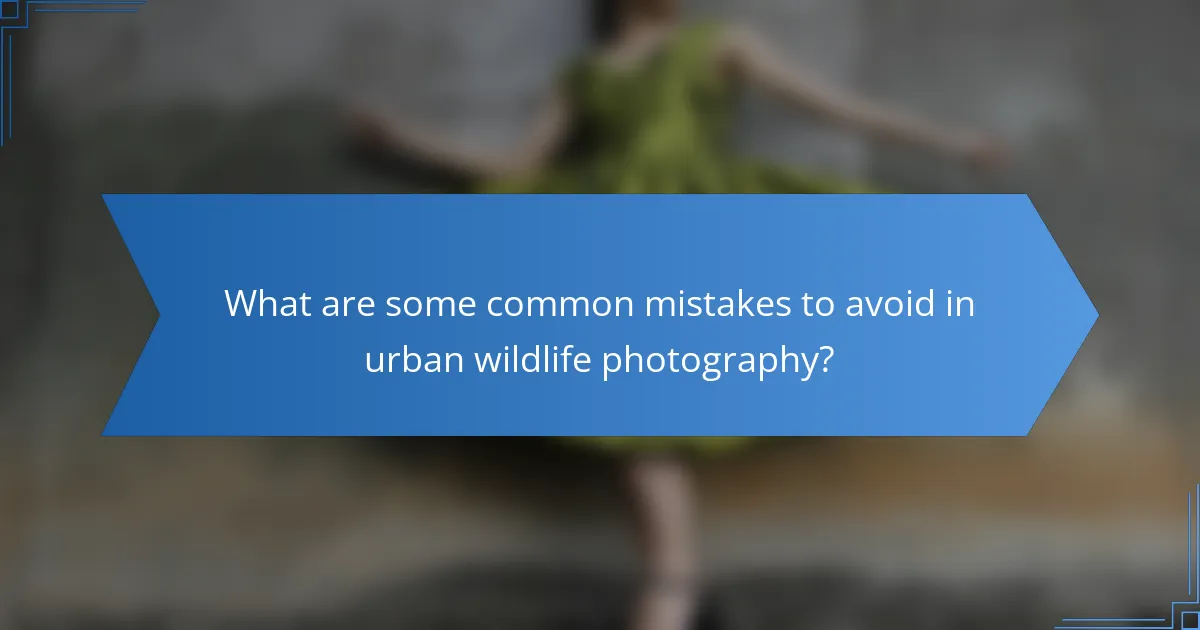
What are some common mistakes to avoid in urban wildlife photography?
Common mistakes in urban wildlife photography include failing to research locations, neglecting lighting conditions, and not respecting wildlife. Many photographers overlook the importance of location scouting, which can lead to missed opportunities for capturing unique moments. Poor lighting can result in unappealing images; early mornings or late afternoons often provide the best natural light. Additionally, approaching wildlife too closely can stress animals and disrupt their natural behavior, compromising the quality of the photographs.
How can photographers ensure they respect wildlife while capturing images?
Photographers can respect wildlife by following ethical guidelines and minimizing disturbance. Prioritize observing animals from a distance, using telephoto lenses to capture images without intruding. Familiarize yourself with local wildlife regulations to ensure compliance. Avoid flash photography, which can startle animals, and be mindful of nesting seasons. Always leave no trace to protect habitats.
What strategies can help avoid disturbances to urban wildlife habitats?
Implementing strategies to avoid disturbances to urban wildlife habitats is essential for preserving biodiversity. Key strategies include creating green corridors, enforcing noise regulations, and promoting native vegetation.
1. Establish green corridors to connect fragmented habitats, allowing wildlife to move safely.
2. Enforce noise regulations to minimize disturbances from urban activities, protecting sensitive species.
3. Promote native vegetation in landscaping to provide natural food sources and shelter.
4. Educate the community about the importance of wildlife and encourage responsible outdoor practices.
These approaches help mitigate urban impacts on wildlife, fostering healthier ecosystems.
How can photographers balance artistic expression with ethical responsibility?
Photographers can balance artistic expression with ethical responsibility by respecting wildlife and their habitats. They should prioritize the well-being of animals while capturing stunning urban nature images.
Ethical considerations include minimizing disturbance to wildlife, avoiding the use of bait, and adhering to local regulations. Photographers can also educate themselves about the species they photograph, ensuring their work promotes conservation efforts.
Utilizing techniques like remote cameras can help capture wildlife without direct interference. This approach allows for artistic expression while maintaining ethical standards.
Lastly, sharing the stories behind the images fosters a deeper connection between the audience and the subject, promoting awareness and respect for urban wildlife.
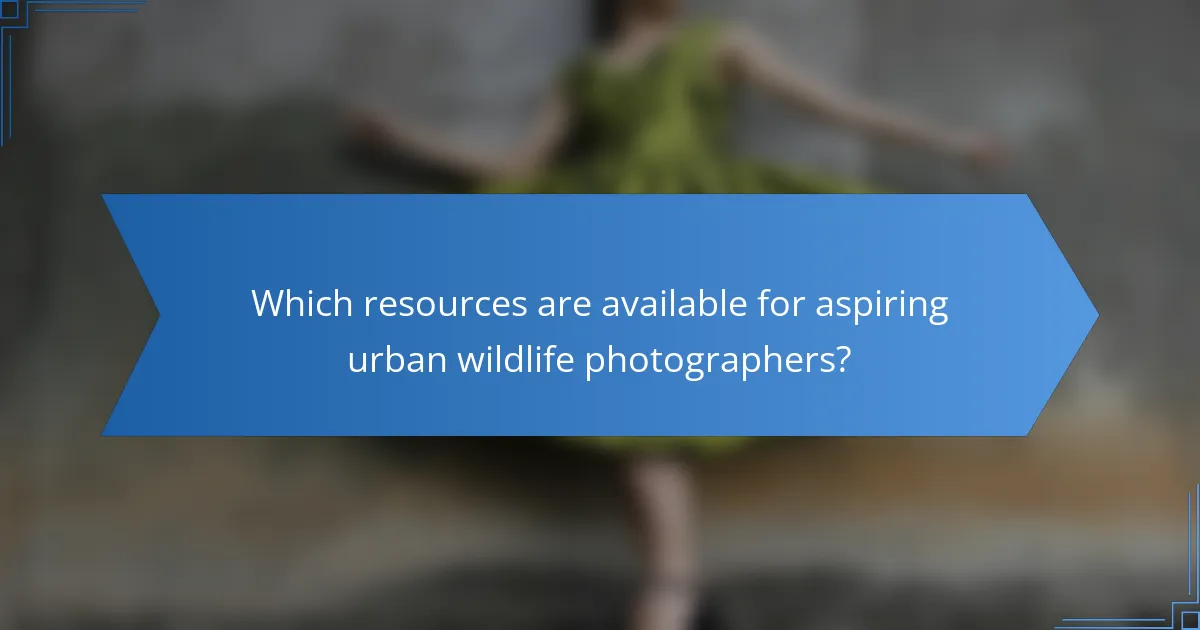
Which resources are available for aspiring urban wildlife photographers?
Aspiring urban wildlife photographers can access various resources to enhance their skills. Online courses offer structured learning on techniques and equipment. Photography forums provide community support and feedback. Local workshops allow hands-on experience in urban settings. Social media groups facilitate networking with other photographers. Additionally, books and blogs offer insights into wildlife behavior and photography tips.
What online communities and forums support urban wildlife photography?
Online communities and forums that support urban wildlife photography include platforms where enthusiasts share tips, images, and experiences. Popular options are Reddit’s r/UrbanWildlife, Facebook groups dedicated to urban nature photography, and specialized forums like Nature Photographers Network. These spaces foster collaboration and learning among photographers facing the unique challenges of capturing wildlife in city environments.
Which books and tutorials can provide guidance on this niche?
Several books and tutorials effectively guide urban wildlife photography. Notable titles include “Urban Wildlife: A Guide to Photographing Nature in the City” and “City Nature: Capturing Urban Wildlife.” Online platforms like YouTube feature tutorials from experienced photographers, offering insights on techniques and challenges specific to city environments. Additionally, workshops and local meetups provide hands-on experience and community support for aspiring urban wildlife photographers.
What are the best practices for sharing urban wildlife photography online?
To effectively share urban wildlife photography online, prioritize quality images and engage with your audience. Use high-resolution photos to showcase details of urban wildlife. Share on platforms like Instagram and wildlife forums to reach enthusiasts. Utilize relevant hashtags to increase visibility and connect with similar content. Engage with your audience by responding to comments and sharing behind-the-scenes insights. Collaborate with local wildlife organizations to raise awareness and promote conservation efforts.